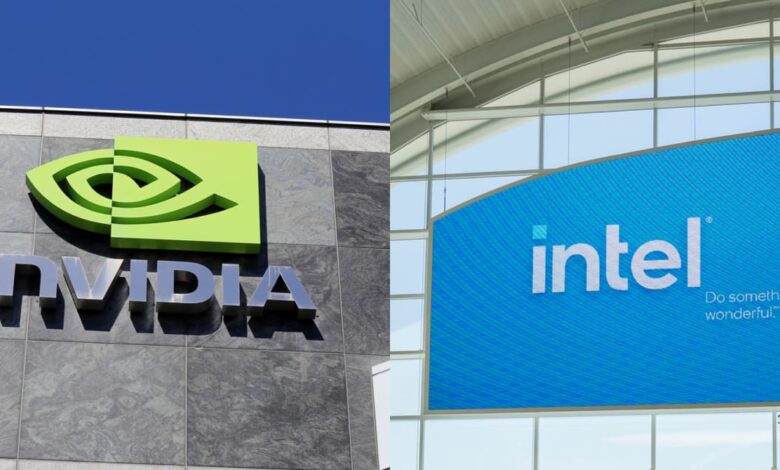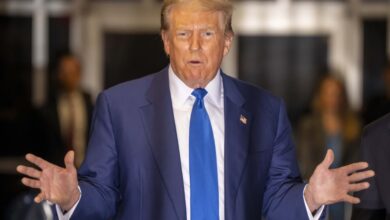Opinion: Nvidia’s growth and Intel’s chip-making plans depend on AI fulfilling its promise

“AI demand isn’t slowing; it isn’t stopping, and those who claim this is a phase or a hiccup in the market are clearly missing the significance.”
This has been a big week for investors banking on the inevitable growth of artificial intelligence. After the U.S. market’s close on Wednesday, Nvidia
NVDA,
released earnings that exceeded expectations. Also on Wednesday, another important event in the tech field took place: Intel’s
INTC,
first-ever chip foundry event in San Jose, Calif.
It should not surprise you that both of these events were focused on AI, but what might surprise is just how connected they are, intertwining the fate of many of today’s tech giants.
Starting with the Nvidia earnings release, the results were excellent. It felt like the 20 minutes between market close and results release took hours, but when the earnings finally crossed the wire, the company showed $22.1 billion in revenue, up 23% over the previous quarter and 265% year-over-year. Margins have continued to rocket upward, hitting 72%. The data center business division that is responsible for AI products saw its revenue rise to $18.4 billion from $14.5 billion quarter-over-quarter.
Nvidia’s outlook for next quarter is revenue of $24 billion and a margin of 77%. That’s a modest increase over the current results, but Nvidia is probably doing its best to limit expectations and help it produce another “beat and raise” opportunity three months from now.
What these numbers tell us is that AI demand isn’t slowing; it isn’t stopping, and those who claim this is a phase or a hiccup in the market are clearly missing the significance. Nvidia doesn’t see any slowing of this insatiable need for AI computing, and all other indications from the tech industry corroborate this.
“Intel’s intent is to make as many of the AI chips the world needs as it can.”
Recently OpenAI’s Sam Altman made headlines when he said he was looking to find $7 trillion from a combination of governments and investors to rework how the world builds and distributes chips and chip-manufacturing capability for AI. While most analysts believe this $7 trillion number is more of a scare tactic, meant to get the industry moving faster and investing, I see it as Altman preparing the U.S. and other governments to step up their contribution.
Altman was one of the guest speakers at the Intel foundry event. Intel brought in financial and industry analysts to showcase its continued momentum for its chip-manufacturing strategy. Now officially called “Intel Foundry”, the company is split into “foundry” and “products” divisions, with the latter responsible for building the IP for chips that power laptops, PCs, and data center servers.
Intel CEO Pat Gelsinger stated clearly that his intent was to make as many of the AI chips the world needs as it can. That means producing chips and providing packaging for Nvidia, Arm Holdings
ARM,
Microsoft
MSFT,
and others. It’s a powerful transition: if Intel continues to struggle to find ways to compete in the AI space with its own products, where its Gaudi and GPU accelerators have had issues finding a foothold, then it can still benefit financially, and be a big player in the AI market, if it can create a leading process technology and assert itself as the preeminent domestic provider.
Read: CEOs of Intel, OpenAI chat about future of AI and ‘mind-boggling’ need for chips
Plus: Nvidia’s sheer dominance can be summed up by this one underrated number
Two of the more intriguing partners to share the stage with Intel were Microsoft and Arm. Microsoft CEO Satya Nadella said in a recorded video that the company had agreed to build one of its upcoming AI chips using the Intel 18A process node, though details on the volume or performance level of that chip aren’t known. Nadella added that Microsoft was committed to helping making Intel a strong player in the chip production ecosystem.
The language about Intel’s relationship with Arm was even more concrete. Intel stated that Arm was “our most important partner,” and in many ways that’s a given. A reported 80% of the chips that leave Taiwan Semiconductor Manufacturing’s
TSM,
fab facilities have at least one Arm CPU core in them, so it’s imperative that Intel have the capabilities to efficiently produce Arm chips.
Gelsinger is placing a significant bet that the Intel Foundry business is the company’s future. It’s obvious that for every Arm Neoverse-based chip that ships that means one fewer x86 part is selling, so by building best-in-class Arm-based silicon in its fabs, Intel is potentially trading market share in the product space for market share in the manufacturing segment.
Both Nvidia’s earnings success and Intel’s clear dedication to being a leading foundry for AI chips are wins for other players in the AI market. AMD
AMD,
shares, for example, rose on the tailwind of Nvidia’s growth, as investors (correctly) assume that the larger this market becomes, the more room for AMD products. But even the likes of Qualcomm
QCOM,
IBM
IBM,
Alphabet
GOOGL,
GOOG,
and Meta Platforms
META,
will see the global growth in AI as an opportunity.
Businesses and consumers want AI-powered capabilities in their computing devices and infrastructure. That will boost demand for laptops and devices with AI acceleration and for servers to train the AI models and feed them data.
Ryan Shrout is the president of Signal65 and founder at Shrout Research. Follow him on X @ryanshrout. Shrout has provided consulting services for AMD, Qualcomm, Intel, Arm Holdings, Micron Technology, Nvidia and others. Shrout holds shares of Intel.
Also read: Nvidia’s stock rockets upon earnings beat as AI demand hits ‘tipping point’
More: OpenAI’s Sam Altman has plans for AI that could mean big money for Intel





